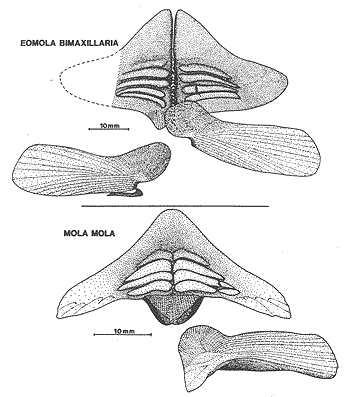Evolution
A long time ago in a tropical place far, far away, a strange group of tailless fishes emerged from a coral reef and over millions of years took to the coastal waters–and the neighborhood’s never been the same since. . .
Ocean Sunfish (family Molidae) Evolution:
Sunfishes comprise a family of charismatic, pelagic (open ocean) fishes that occur in tropical and temperate ocean basins (Fraser-Brunner 1951). Their peculiar body features often prompt interest in where they may be placed in evolutionary history.
Sunfishes (family Molidae) are in the same order (Tetraodontiformes) as puffers (family Tetraodontidae) and porcupine fishes (family Diodontidae). As their order name suggests, these related groups of fishes have features in common: four (“tetra”) fused teeth (“odont”) that form a beak and scales modified into prickly spines (Cuvier 1817). The sunfishes’ truncated appearance can be attributed, in part, to the disappearance of the more typical teleost (fish) caudal peduncle and emergence of their unique posterior structure called the clavus, Latin for rudder. The clavus is made from modified elements of the dorsal and anal fins (Frasier-Brunner 1951, Johnson and Britz 2005). Lacking a caudal fin and having a fused stiffened backbone, sunfishes do not wag their bodies to swim but rather flap along using their dorsal and anal fins (e.g., Watanabe and Sato 2008, Davenport et al. 2018, Watanabe and Davenport 2020).
Fossil Record:
Ocean sunfishes are not well represented in the fossil record for two primary reasons: their habitat (the epipelagic) and their weakly ossified skeletons make it difficult for fossilization to occur and to locate the rare fossils that do exist. Most of the known sunfish fossils are incomplete. The jaws or dermal plates (hardened layer of skin) are the only bits typically found (Santini and Tyler 2003). The earliest known sunfish fossils – two jaws and cranial (skull) bones – are from the Caucasus, Russia and originated from specimens living in the Middle Eocene (40 million years ago). These fossils are the holotype for the extinct species Eomola bimaxillaria (Tyler and Bannikov 1992). Eomola bimaxillaria had unfused premaxillae (jaw bones), not characteristic of modern sunfishes. It was assigned to the sunfish family (Molidae) however because of two morphological features consistent with other molids–laterally elongate trituration (grinding) teeth and weakly ossified bones with a striped external texture (Carnevale et al. 2020).
The earliest known Mola fossil – a jaw – was found in the Patagonian Formation (late Oligocene – early Miocene), in Argentina (Cuitiño et al. 2017, Woodward 1901). Several middle Miocene – Pliocene fossil jaws, dermal plates, and caudal ossicles have been found in regions of Europe and North America and have been attributed to extinct Mola pileata (van Beneden 1881). Mola pileata has several differences in beak morphology that distinguish it from modern Mola mola (Weems 1985). The slender mola genus, Ranzania, is better well-represented in the fossil record, with four extinct species being represented in the Miocene (Uyeno and Sakamoto 1994, Carnevale 2007, Carnevale and Santini 2007). Overall, the sunfishes’ evolution into different genera and species appears to align with rising ocean productivity and abundance of resources that occurred during the Miocene (e.g., Berger 2007, Norris et al. 2013, Santini et al. 2013, 2014).
Ancient Giants: Austromola angerhoferi
The extinct sunfish Austromola angerhoferi is known from the Early Miocene in Austria from three skeletons. This behemoth is estimated to have been larger than 3 meters (10 feet!) in length–among the largest fishes for this time period(Gregorova et al. 2009).
Molidae Intrarelationships
Morphological and molecular studies suggest that the ocean sunfish genera Masturus and Mola are more closely related to one another than they are to the third extant genus of sunfish, Ranzania (the slender mola) (e.g., Bonaparte 1841, Gill 1897, Fraser-Brunner 1951, Tyler 1980, Santini and Tyler 2002, Yamanoue et al. 2004, Bass et al. 2005, Alfaro et al. 2007, Yoshita et al. 2009 Caldera et al. 2020). Of the modern extanct sunfish genera, Mola occurs earliest in the fossil record (Aquitanian; 23 – 20.4 mya), followed by Ranzania (Langhian; 16 – 13.8 mya), and the third genus of extant sunfish Masturus has not been identified in the fossil record (Carnevale et al. 2020).
Our understanding of sunfish in the fossil record is however limited and as such contains considerable gaps. In the future, researchers hope to fill in these gaps, particularly our knowledge of early sunfish history (pre-Miocene) and the origin of Masturus, which will help our understanding of how sunfish evolved such peculiar bodies (Carnevale et al. 2020).
Ocean Sunfish Evolution FAQ
Ocean sunfishes look ancient—are they?
While members of the Molidae family may appear primitive, they are in fact relative latecomers to the fish world. Fishes first emerged more than 500 million years ago shortly after the Cambrian Explosion and the radiation leading to most modern fishes occurred about 100 million years ago. It took another 50 million years for sunfishes to appear. In fact, molas are thought to be some of the most recently derived fish groups in the sea.
What characteristics group sunfishes in the same family?
While ocean sunfishes have several unique anatomical features, the most striking difference between them and other Tetraodontiformes (the order to which they belong) is that sunfishes do not have a caudal peduncle nor caudal fin. That region of the body is replaced by a structure called a clavus which means rudder in Latin. (Frasier-Brunner 1951, Johnson and Britz 2005).
How do scientists determine the relatedness of different populations of fishes?
Often scientists use both morphological features (body form) and molecular techniques (genetic analyses) to identify how populations or groups may be related to one another.

(From Tyler and Bannikov, 1992)
Cited Literature:
Alfaro, M.E., F. Santini and C.D. Brock. 2007. Do reefs drive diversification in marine teleosts? Evidence from pufferfish and their allies (order Tetraodontiformes). Evolution 61: 2104‒2126.
Bass, A.L., H. Dewar, T. Thys, J.T. Streelman and S.A. Karl. 2005. Evolutionary divergence among lineages of the ocean sunfish family, Molidae (Tetraodontiformes). Mar. Biol. 148: 405‒414.
Beneden, P.-J. van. 1881. Sur un poisson fossile nouveau des environs de Bruxelles et sur certain corps énigmatiques du crag d’Anvers. Bull. Acad. R. Sci. Lett. Beaux-Arts Belgique (3eme série) 1: 116‒126.
Berger, W.H. 2007. Cenozoic cooling, Antarctic nutrient pump, and the evolution of whales. Deep-Sea Res. II 54: 2399‒2421.
Bonaparte, C.L. 1841. Iconografia della fauna italica per le quattro classi degli animali vertebrati. Tomo III. Pesci. Tipografia Salviucci, Roma.
Caldera, E., J. Whitney, M. Nyegaard, L. Kubicek and T.M. Thys. 2021. Genetic Insights regarding the Taxonomy, Phylogeography and Evolution of the Ocean Sunfishes pp. 37-55 In: T. M. Thys, G.C. Hays and J.D.R. Houghton [eds.]. The Ocean Sunfishes: Evolution, Biology and Conservation, CRC Press. Boca Raton, FL, USA.
Carnevale, G. 2007. Fossil fishes from the Serravallian (Middle Miocene) of Torricella Peligna. Palaeont. It. 91: 1‒67.
Carnevale, G. and F. Santini. 2007. Record of the slender mola, genus Ranzania (Teleostei, Tetraodontiformes), in the Miocene of the Chelif Basin, Algeria. C.R. Palevol 6: 321‒326.
Carnevale, G., L. Pellegrino, J.C. Tyler. 2021. Evolution and Fossil Record of the Ocean Sunfishes pp. 1-18 In: T. M. Thys, G.C. Hays and J.D.R. Houghton [eds.]. The Ocean Sunfishes: Evolution, Biology and Conservation, CRC Press. Boca Raton, FL, USA.
Cuitiño, J.I., M.T. Dozo, C.J. del Río, M.R. Buono, L. Palazzesi, S. Fuentes and R.A. Scasso. 2017. Miocene marine transgressions: Paleoenvironments and paleobiodiversity. pp. 47‒84. In: P. Bouza and A. Bilmes [eds.]. Late Cenozoic of Peninsula de Valdés, Patagonia Argentina: an interdisciplinary approach. Springer, Cham.
Cuvier, G. 1817. Le Règne Animal, Vol. 2. Deterville, Paris.
Davenport, J., N.D. Phillips, E. Cotter, L.E. Eagling and D.R. Houghton. 2018. The locomotor system of the ocean sunfish Mola mola (L.): role of gelatinous exoskeleton, horizontal septum, muscles and tendons. J. Anat. 233: 347‒357.
Fraser-Brunner, A. 1951. The ocean sunfishes (family Molidae). Bull. Brit. Mus. (Nat. Hist.) Zool. 1(6): 89‒121.
Gill, T.N. 1897. The distinctive characters of the Molinae and Ranzaniinae. Science 156: 966‒967.
Gregorova, R., O. Schultz, M. Harzhauser, A. Kroh and S. Ćoric. 2009. A giant early Miocene sunfish from the North Alpine Foreland Basin. J. Vert. Paleont. 29: 359‒371.
Johnson, G.D. and R. Britz. 2005. Leis’ Conundrum: Homology of the clavus of the ocean sunfishes. 2. Ontogeny of the median fins and axial skeleton of Ranzania laevis (Teleostei, Tetraodontiformes, Molidae). J. Morphol. 266: 11‒21.
Norris, R.D., S. Kirtland Turner, P.M. Hull and A. Ridgwell. 2013. Marine ecosystem responses to Cenozoic global change. Science 341: 492‒498.
Santini, F. and J.C. Tyler. 2002. Phylogeny of the ocean sunfishes (Molidae, Tetraodontiformes), a highly derived group of teleost fishes. Ital. J. Zool. 69: 37‒43.
Santini, F. and J.C. Tyler. 2003. A phylogeny of the families of fossil and extant tetraodontiform fishes (Acanthomorpha, Tetraodontiformes), Upper Cretaceous to Recent. Zool. J. Linn. Soc. 139: 565‒617.
Santini, F., L. Sorenson and M.E. Alfaro. 2013. A new phylogeny of tetraodontiform fishes (Tetraodontiformes, Acanthomorpha) based on 22 loci. Mol. Phylogen. Evol. 69: 177‒187.
Santini, F., G. Carnevale and L. Sorenson. 2014. First multi-locus timetree of seabreams and porgies (Sparidae, Percomorpha). Ital. J. Zool. 81: 55‒71.
Tyler, J.C. 1980. Osteology, phylogeny, and higher classification of the fishes of the order Plectognathi (Tetraodontiformes). NOAA Tech. Report, NMFS Circ. 434: 1‒422.
Tyler, J.C. and A.F. Bannikov. 1992. New genus of primitive ocean sunfish with separate premaxillae from the Eocene of Southwest Russia (Molidae, Tetraodontiformes). Copeia 1992: 1014‒1023.
Tyler, J.C. and F. Santini. 2002. Review and reconstructions of the tetraodontiform fishes from the Eocene of Monte Bolca, Italy, with comments on related Tertiary taxa. St. Ric. Giacim. Terz. Bolca 9: 47‒119.
Uyeno, T. and K. Sakamoto. 1994. Ranzania ogaii, a new Miocene slender mola from Saitama, Japan (Pisces: Tetraodontiformes). Bull. Natn. Sci. Mus., Tokyo, Ser. C. 20: 109‒117.
Watanabe, Y.Y. and J. Davenport. 202X. Locomotor systems and biomechanics of the Ocean Sunfish pp. 72-87 In: T.M.Thys, G.C. Hays and J.D.R. Houghton [eds.]. The Ocean Sunfishes: Evolution, Biology and Conservation, CRC Press. Boca Raton, FL, USA.
Watanabe, Y. and K. Sato. 2008. Functional dorsoventral symmetry in relation to lift-based swimming in the ocean sunfish Mola mola. PLoS ONE 3: e3446.
Weems, R.E. 1985. Miocene and Pliocene Molidae (Ranzania, Mola) from Maryland, Virginia, and North Carolina (Pisces: Tetraodontiformes). Proc. Biol. Soc. Wash. 98: 422‒438.
Woodward, A.S. 1901. Catalogue of Fossil Fishes in the British Museum (Natural History). Vol. IV. The Trustees of the British Museum, London.
Yamanoue, Y., M. Miya, K. Matsuura, M. Katoh, H. Sakai and M. Nishida. 2004. Mitochondrial genomes and phylogeny of the ocean sunfishes (Tetraodontiformes: Molidae). Ichthyol. Res. 51: 269‒273.
Yoshita, Y., Y. Yamanoue, K. Sagara, M. Nishibori, H. Kuniyoshi, T. Umino et al. 2009. Phylogenetic relationship of two Mola sunfishes (Tetraodontiforme: Molidae) occurring around the coast of Japan, with notes on their geographical distribution and morphological characteristics. Ichthyol. Res. 56: 232‒244.
